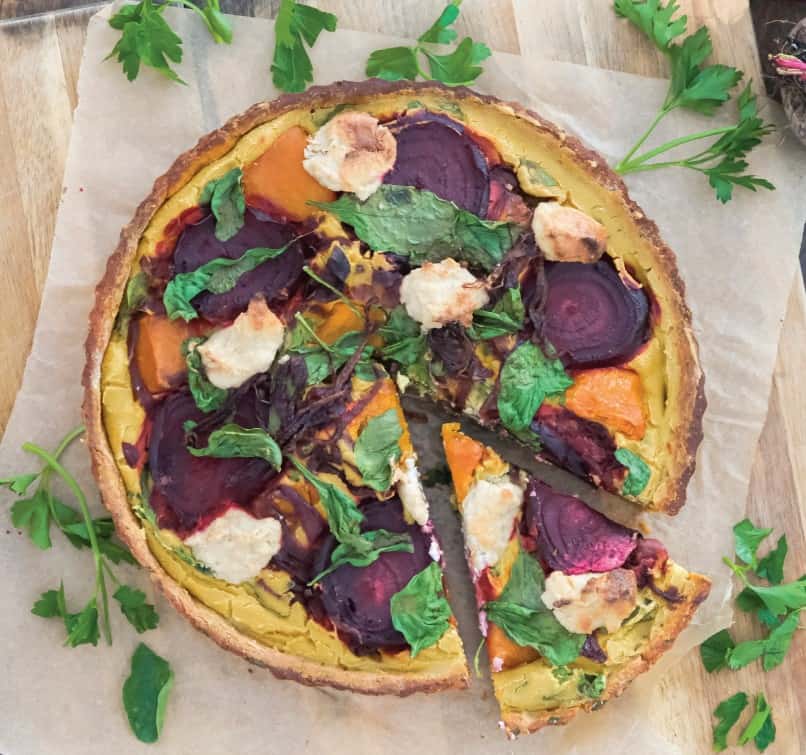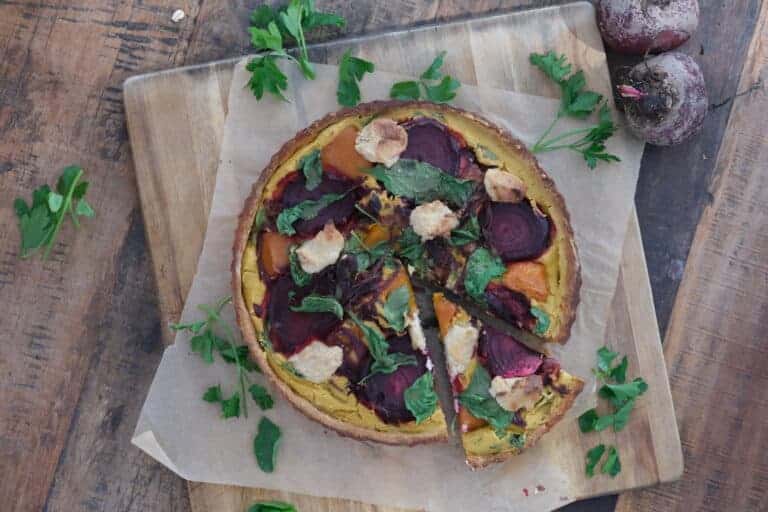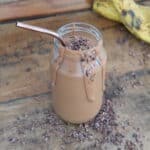Quiche is something I grew up eating a lot of. I say this with the most love in the world… but the main reason for this was that it was one of the only things my Mum could actually cook! (Love you Mum xx)
Saying that, it actually was something I really enjoyed. So when I became vegan, I didn’t think I would ever really be able to enjoy the humble quiche again. Wow was I wrong!
The first came I came across the concept of tofu quiche was in a little side ally vegan store in the backstreets of Sydney, they had an amazing range of vegan deli-style food and decided to give it a go. The first bit was shocking, in a good way! It was warm, flavourful, cheesy and … actually eggy! I was dumbfounded! How did this tofu quiche have the sulfur-like aroma and taste of egg??
So I started digging, and I found it! The magic ingredient… black salt.
What is black salt?
Black salt, also known as kala namak or Himalayan black salt, is a type of rock salt that is commonly used in South Asian cuisine. Despite its name, it is not actually black in color; rather, it ranges from pinkish-gray to dark purple.
Black salt is typically harvested from salt mines in the Himalayan regions of India, Pakistan, Nepal, and Bangladesh. It gets its distinctive color and flavor from the presence of trace minerals and sulfurous compounds, particularly iron sulfide, which gives it a unique aroma reminiscent of boiled eggs.
In cooking, black salt is often used as a flavor enhancer and seasoning in various dishes, especially in vegan and vegetarian cuisine to mimic the taste of eggs. It can be added to salads, chaats, chutneys, and other savory dishes to provide a savory, umami flavor.
Due to its strong aroma and flavor, black salt is used sparingly in cooking. It is available in both coarse and fine varieties, and it is commonly used in powdered form. Additionally, black salt is believed to have some medicinal properties and is used in Ayurvedic medicine to treat digestive issues and other ailments.
If you’ve never tried it, definitely try and get your hands on some! It will transform your vegan dishes trying to immitate egg and take them to the next level. Just don’t go too heavy handed on it, trust me, less is more!
Tofu vs Eggs
Now obviously in this particular recipe, we’re replacing the major main component of eggs with tofu. If you’re already a vegan, then this choice is simple. However if you’re not vegan what are some reasons why you might want to put a tofu quiche on your plate vs the standard egg quiche? Well sit tight, I’ll give you a few:
Nutrition
Here’s a breakdown of the nutritional content of eggs and tofu per 100 grams:
Eggs:
- Calories: Approximately 155 kcal
- Protein: Around 13 grams
- Fat: About 11 grams, including saturated, monounsaturated, and polyunsaturated fats
- Cholesterol: Typically contains around 370 milligrams
- Vitamins: Rich in vitamin B12, vitamin D, riboflavin (B2), and choline
- Minerals: Contains iron, phosphorus, selenium, and trace amounts of calcium
Tofu:
- Calories: Approximately 70 kcal
- Protein: Roughly 8 grams
- Fat: About 4 grams, primarily unsaturated fats
- Cholesterol: Virtually cholesterol-free
- Vitamins: Contains vitamins E, K, and some B vitamins, particularly B2 (riboflavin) and B6
- Minerals: Rich in calcium, iron, magnesium, phosphorus, potassium, and manganese
From a health perspective, you can see that from a caloric and cholesterol standpoint, tofu is superior. Tofu provides a lower amount of fat per 100g and still a significant amount of protein per serve. The vitamins and mineral content are where the main differences lie, with the only thing tofu really lacks here is B12 and choline, and given that you can often buy B12 fortified tofu in most stores these days, the differences are really quite minimal.
So now we can see that tofu is a valid nutritional substitute, what about from a sustainability perspective?
Sustainability
The question, is tofu sustainable, is a pretty loaded one. That is because while tofu doesn’t emit nearly as much CO2 into the environment or contribute as severely to deforestation and climate change as meat products, the process of tofu production isn’t truly clean. In saying that, most food products will have some kind of impact.
If we compare the ecological footprint of eggs vs tofu, we would discuss the following;
Eggs:
- Land Use: Egg production typically requires significant land use for chicken farming, including space for housing, feed production, and waste management. However, the amount of land needed per egg can vary depending on farming practices.
- Water Use: Water consumption in egg production includes water for chicken drinking, cleaning facilities, and irrigating feed crops. While not as water-intensive as some animal agriculture practices, egg production still requires a considerable amount of water.
- Greenhouse Gas Emissions: Chicken farming contributes to greenhouse gas emissions, primarily through methane and nitrous oxide released from manure and feed production. However, compared to other livestock, such as cattle, poultry farming generally has lower emissions per unit of protein produced.
- Feed Conversion Efficiency: Chickens are relatively efficient at converting feed into edible protein, requiring less feed per unit of protein compared to some other livestock. However, the environmental impact of feed production, particularly if it includes soybean meal, can still be significant.
Tofu:
- Land Use: Tofu production typically requires less land compared to animal agriculture. Soybeans can be grown in a variety of climates and are often cultivated as rotation crops, which can help improve soil health and reduce erosion.
- Water Use: Soybean cultivation generally requires less water compared to raising animals for food. However, water usage can vary depending on farming practices and irrigation methods.
- Greenhouse Gas Emissions: While tofu production does produce greenhouse gas emissions, it generally has a lower carbon footprint compared to animal agriculture. However, emissions associated with transportation and processing should also be considered, especially for tofu that is imported from distant regions.
- Feed Conversion Efficiency: Soybeans are relatively efficient at converting sunlight, water, and nutrients into protein. Tofu production typically requires less feed input compared to animal-based protein production, resulting in lower environmental impacts overall.
The irony of this debate, is when you actually look just a little deeper, you find out. Soybeans are the cheapest way to keep livestock fed and are the largest global source of protein for farm animals. Since meat consumption and livestock feeding on soy are inextricably linked, the best way to halt soy-related deforestation is to curb meat and poultry (as well as produces of these industries) consumption.
A study found that if Germany’s population significantly lowered their meat consumption, around 1.8 million acres of agricultural land would be saved. If every person in the US completely removed meat from their personal menu, the extra grain would be enough to feed around 1.4 billion people.
Overall, tofu tends to have a lower environmental footprint compared to eggs when considering factors such as land use, water use, greenhouse gas emissions, and feed conversion efficiency. However, in order to ensure that you are choosing the most sustainable option, when buying tofu, read labels carefully.
Some tofu sold worldwide may be sourced from deforested lands in Brazil, so avoid buying Brazilian tofu if you live outside of South America. And if you live in South America, be sure to source tofu from a trusted local source. If you live elsewhere, look for organic tofu that was sourced as close to your home country as possible. Bottom line, stick to buying organic and locally sourced tofu.
Now we’ve covered that, let’s get back to baking!
Tips for the best vegan tofu quiche
Tips for Vegan Tofu Quiche Success:
- Prepare Ingredients in Advance: Roast the beetroots and pumpkin beforehand to save time. Ensure they are slightly undercooked as they will be further cooked in the quiche.
- Crust Consistency: Aim for a dough-like consistency when preparing the crust. Add water gradually to achieve the right texture.
- Pre-Bake Crust: Partially pre-bake the crust before adding the filling. This ensures the crust sets properly and prevents it from becoming soggy.
- Tofu Filling Texture: Process the tofu filling until creamy for a smooth texture. Ensure all ingredients are well combined.
- Adjust Milk Quantity: Depending on the moisture content of the tofu, you may need to adjust the amount of plant-based milk. Add more or less as needed to achieve the desired consistency.
- Even Distribution of Ingredients: Stir in the herbs and spinach evenly into the tofu mixture for uniform flavor distribution.
- Sauteed Onions and Garlic: Properly sauté the onions and garlic until golden and fragrant before adding them to the tofu mixture. This enhances their flavor.
- Decorative Toppings: Arrange slices of beetroot and pumpkin on top of the quiche for an attractive presentation. Add optional vegan cheese or garlic cream for extra flavor.
- Check for Doneness: Insert a knife into the quiche to check if the tofu is set and not wet. Adjust baking time as needed, covering with foil if it browns too quickly.
- Allow to Cool: Let the quiche cool for at least 15 minutes before slicing to prevent it from crumbling apart.
Frequently Asked Questions (FAQs) for Vegan Tofu Quiche:
- Can I use a different type of flour for the crust? Yes, you can use spelt or lentil flour as alternatives to chickpea flour for the crust.
- Can I substitute almond milk with another plant-based milk? Yes, you can use any unsweetened plant-based milk such as soy milk or oat milk.
- Can I omit the nutritional yeast? Nutritional yeast adds a cheesy flavor to the quiche, but you can omit it if desired, I wouldn’t personally recommend it.
- Can I use regular salt instead of black salt? Black salt (kala namak) adds an eggy flavor to the quiche, so if you omit this you won’t quite get that eggy taste.
- Can I make this quiche gluten-free? Yes, you can use a gluten-free flour blend instead of chickpea flour for a gluten-free crust.
- Can I freeze leftovers? Yes, you can freeze leftover quiche slices in an airtight container for future consumption. Reheat in the oven or microwave before serving.
- Can I customize the fillings? Yes, feel free to customize the fillings with your favorite vegetables, herbs, or vegan cheese alternatives.

Vegan Quiche with Roasted Beet, Pumpkin and Spinach
Equipment
- 1 Food processor
- 1 baking tray
- 1 Quiche tray
Ingredients
Crust
- 1 TBSP flax seed (ground + 3 TBS water mixed together (flax egg))
- 1.5 cups pumpkin roughly chopped
- 2 cups chickpea flour (or spelt/lentil will work also)
- ½ tsp baking powder
- Pinch fine pink salt
Quiche
- 3 block firm tofu (250g)
- 6 minced garlic cloves
- 2 TBSP hulled tahini
- 3 baby beetroots
- 3 cup baby spinach (or other leafy greens – kale will also work)
- 1 cup nutritional yeast
- 2 TBSP turmeric
- 1 red onion
- 1 TBSP olive oil
- ½ cup chives
- 1.5 cup plant based milk (soy works well – unsweetened – add more or less depending on the wetness of your tofu)
- Pinch of black salt
Instructions
- Preheat the oven to 160 degrees. Lightly grease a round 10 inch tart pan (can also use 9 inch glass dish also)
- Wrap beetroot in alfoil and place on a baking tray – bake for 40 minutes or until you can pierce with a knife. At the same time you can either bake off your pumpkin by slicing into large chunks and placing in the oven, or you can pan steam by placing a small amount of oil on a pan and placing a lid overtop. Filp halfway through. Make sure to slightly undercook pumpkin as it will be cooked further when in the quiche itself.
- While your beetroot and pumpkin are cooking, prepare your crust – add all crust ingredients to the food processor until mixture resembles a dough.
- Brush tart pan/tin with oil. Knead your dough and roll out with a rolling pin and then place in your tart tin, pressing into edges and making nice and neat.
- Bake crust for 2-3 minutes or until it’s slightly dry to touch. Better to undercook as it will cook further later.
- Now time to make the filling. Break apart tofu into pieces and add to the food processor with almond milk, nutritional yeast, turmeric, black salt, tahini, salt. Process until creamy.
- Stir in herbs and spinach until all mixed together.
- In a pan, sauté onion and garlic. Once cooked remove from heat and stir into processed tofu mix.
- Place mixture into cooked crust. Cut a slice of beetroot and pumpkin and place on top and decorate with blobs of optional vegan cheese (feta would work best, or use our garlic cream/aioli recipe which works really well!)
- Bake quiche uncovered for 40-50 minutes until quiche is firm. If the quiche is browning too quickly, cover with foil. If you can insert a knife and the tofu is set or not wet it’s ready to come out.
- Cool quiche for 15 minutes before attempting to slice otherwise it may crumble apart. Enjoy!



